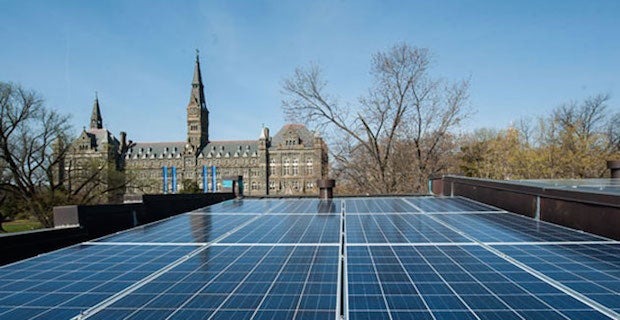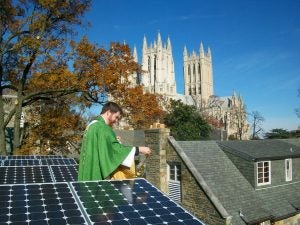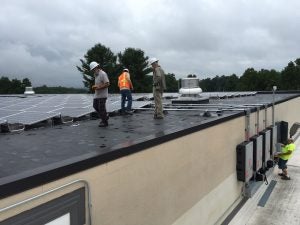Solar for nonprofits
A big opportunity
Going solar is one of the most important things your organization can do to promote energy independence, boost the local economy, reinvest money into mission-driven work, and model environmental stewardship. It’s also a great way to reduce your electricity costs for the long-term. Electricity costs are an often-overlooked expense for nonprofit organizations.
The Inflation Reduction Act (IRA) of 2022 makes going solar can be even more beneficial for tax-exempt organizations. Read below to learn more about taking your organization solar.
Incentives to help your organization go solar
Direct pay
Eligible nonprofit organizations and other tax-exempt entities can benefit from the federal tax credit through a provision in the Inflation Reduction Act (IRA) of 2022 called Elective (or “Direct”) Pay. Direct pay that allows your nonprofit organization to be paid for the value of the tax credit by the IRS. Your organization will need to file required tax forms after the project is complete to receive this payment.
The tax credit is 30% of the installed system cost through 2032. It steps down to 26% in 2033 and 22% in 2034. Organizations do not need to be approved to receive this benefit. You just need to qualify based on the specific rules of the tax credit for which you are applying. Some projects may be eligible for an increased credit if they meet certain requirements. These increases are called special adders.
State and local incentives
States, local jurisdictions, and some utilities may also offer incentives for nonprofit organizations going solar. These may come in the form of:
- Grants,
- Special financing,
- property tax exemptions, or
- technical assistance
Check with your local installer and your state’s energy office for more information.
How to finance solar for your organization
Nonprofits have two options to pay for a system:
Direct ownership
With direct ownership, your nonprofit will buy the system for your building or property. You will own all system components and all of its electrical output. Direct ownership of a system makes sense for your organization if you:
- are able to raise funds to cover the cost of the project,
- offer cash up front,
- arrange for loan financing, or
- get access to specific state incentives and grants.
Elective (“Direct”) Pay is available for directly owned projects. This allows your nonprofit to claim the federal tax credit.
Nonprofit organizations are uniquely suited to go solar through direct ownership. This is because they often have dedicated members eager to help fundraise and donate. Crowdfunding campaigns can be a successful approach to raise money and rally your members around a solar project.
Third-party ownership (if available in your state)
Under third-party ownership, a separate entity owns and operates the system on your behalf. Examples of entities that do this include a solar developer or a group of community investors.
There are two ways to go solar through third party ownership:
1. Power purchase agreement
Under a power purchase agreement you pay the third party for the monthly electricity produced by the system.
Note: Third-party ownership is only available in certain states. Find out where.
2. Lease
With a lease, you pay a third party for the use of the system. You get the electricity savings the system generates.
Under both ways, the third-party directly claims all of the associated incentives for the system. This includes any tax credits. The third party then passes some of the value of those incentives to you in the form of lower monthly payments. Many nonprofits prefer third-party ownership. Third-party ownership makes sense for nonprofits that lack the upfront cash and/or the financing abilities to purchase their system outright.
A few financing options:
- Community Development Financing Institutions (CDFIs): See if there’s one in your area that offers loan products for nonprofits.
- Green Banks: Is there a Green Bank operating in your area? See if they have nonprofit loan products
- CollectiveSun: provides multiple financing options for nonprofit solar projects.
- Everybody Solar: helping nonprofits go solar through a combination of grant writing, sponsorships, crowd-sourcing and fundraising events
- RE-volv: a platform for crowdfunding for nonprofit solar projects.
Is there a financing option missing above? Let us know!

Engage your community around solar energy
Nonprofits are always looking for ways to engage their members and supporters.
When going solar, you can create unique opportunities for members to get involved with fundraising, designing, and education related to the installation. By helping your organization go solar, members can contribute to lasting electricity bill savings. Over time, those savings really add up.

SUPPORT OUR WORK
Make a tax-deductible donation today to Solar United Neighbors to help more people go solar, join together, and fight for their energy rights.
Don’t have a site for solar?
Partner with Solar United Neighbors to promote solar in your community!
Whether you can put solar on your property or not, nonprofits can partner with Solar United Neighbors to promote going solar to their members. In some areas of the country, our solar co-ops bring together interested homeowners and business owners, educate them about solar, and leverage their bulk purchasing power to secure the most competitive installation pricing in the area. And anywhere in the United States, you can encourage community members to use our free National Solar Help Desk for support when going solar.

Resources
- Ready, Set, Solar! – Sign up for this timed, email-based series that leads you step-by-step through taking your organization solar.
- Solar for Nonprofits webinar (July, 2023) (60 min.) – We take you through important considerations for taking a nonprofit solar.
- Request for Proposals Guide & Template for Nonprofits – This report from the All Points North Foundation outlines steps nonprofits should take when considering solar.
- Elective (or “Direct”) Pay for Federal Tax Credits – The IRS site for this program that lets tax-exempt organizations claim a federal tax credit for qualifying renewable energy installations.
- Technical assistance options for Community-Based Organizations – A database from the Clean Energy States Alliance (CESA)
- Solar for Schools (Generation 180) – Learn about other schools that have gone solar and how to start up a campaign to take your school solar.
- Going Solar for Congregations – Find some inspiration reading about congregations that have gone solar all over the country.
